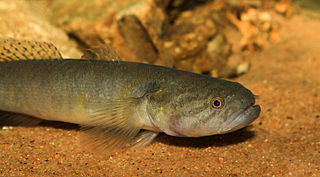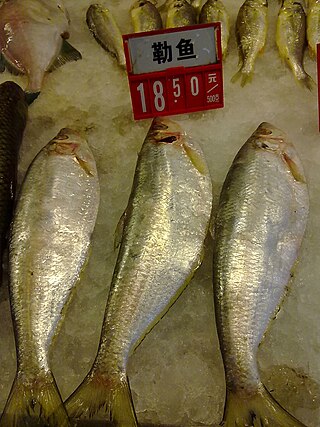
Sprat is the common name applied to a group of forage fish belonging to the genus Sprattus in the family Clupeidae. The term also is applied to a number of other small sprat-like forage fish. Like most forage fishes, sprats are highly active, small, oily fish. They travel in large schools with other fish and swim continuously throughout the day.

Franz Steindachner was an Austrian zoologist, ichthyologist, and herpetologist. He published over 200 papers on fishes and over 50 papers on reptiles and amphibians. Steindachner described hundreds of new species of fish and dozens of new amphibians and reptiles. At least seven species of reptile have been named after him.

Sprattus is a genus of small oily fish of the family Clupeidae. They are more usually known by their common name, sprats. There are five species in the genus.

Rineloricaria is a genus of freshwater tropical catfish belonging to the family Loricariidae. They are commonly called whiptail catfish because of the long filament that grows out of the tip of the caudal fin that is characteristic of the genus. With the exception of R. altipinnis from Panama, they are native to the rivers of northern and central South America. Some species are regularly seen in the aquarium trade.

Sardinella is a genus of fish in the family Dorosomatidae found in the Atlantic, Indian and Pacific Ocean. They are abundant in warmer waters of the tropical and subtropical oceans. Adults are generally coastal, schooling, marine fish but juveniles are often found in lagoons and estuaries. These species are distinguished by their ranges and by specific body features, but they are often confused with one another. Fish of the genus have seven to 14 striped markings along the scales of the top of the head. The paddle-shaped supramaxilla bones are characteristic; they separate Sardinella from other genera and their shapes help distinguish species. They have paired predorsal scales and enlarged fin rays.
Parastegophilus is a genus of pencil catfishes native to South America.

Bostrychus is a genus of fishes in the family Butidae mostly native to eastern Asia to Australia with one species being found along the Atlantic coast of Africa. While some of these species are restricted to freshwater, most can be found in marine, fresh and brackish waters.

Brycon is a genus of fish in the family Bryconidae and order Characiformes found in freshwater habitats in Central and South America, ranging from southern Mexico to northern Argentina. Despite not being closely related to true trout, they are sometimes called South American trout. Members of the genus may be referred to by a number of other different common names in various languages. They reach a maximum length of 11.9–79.5 cm (4.7–31.3 in) depending on the species involved. Some species perform seasonal breeding migrations.

Scarus is a genus of parrotfishes. With 52 currently recognised extant species, it is by far the largest parrotfish genus. The vast majority are found at reefs in the Indo-Pacific, but a small number of species are found in the warmer parts of the eastern Pacific and the western Atlantic, with a single species, Scarus hoefleri in the eastern Atlantic. Most are very colourful, and have strikingly different initial and terminal phases. Adults of most species reach maximum lengths of between 30 and 50 cm (12–20 in), but the rainbow parrotfish can grow to lengths of 1.2 m (3.9 ft).

Chaetostoma, also known as the bristlemouth catfish, is a genus of suckermouth armored catfishes native to South America with one species, C. fischeri, extending into Panama. Most species inhabit flowing rivers in the lower Andes and its foothills. Some species are kept in unheated aquaria.

Ilisha is a genus of ray-finned fishes in the family Pristigasteridae. The genus contains 16 species. It is similar to Pellona but lacks a toothed hypo-maxilla. The genus has a worldwide distribution in tropical and subtropical coastal waters and estuaries. Some species also enter rivers, and I. amazonica and I. novacula are largely–if not entirely–restricted to tropical rivers.

Anchoa is a genus of ray-finned fishes in the family Engraulidae. It currently consists of 35 species.

Prochilodus is a genus of freshwater fish from the family Prochilodontidae. This family include two other genera, Ichthyoelephas and Semaprochilodus, which have been included in Prochilodus instead. The greatest species richness of Prochilodus is in river basins in eastern, southeastern and southern Brazil, but there are also species in the river basins of the Amazon, Guianas, Colombia, Venezuela, Paraguay and northeastern Argentina. The largest species in the genus reach about 80 centimetres (2.6 ft) in length, but most species barely reach half that size.

Gasteropelecus is a genus of freshwater hatchetfishes found in Central and South America. This genus includes some popular aquarium fishes. There are currently three described species in this genus.

The blind goby is a species of fish in the goby family Oxudercidae, the only species in the genus Typhlogobius. It is native to the coastlines of southern California in the United States and Baja California in Mexico, where it commonly inhabits the burrows of shrimp of the genus Callianassa. The adult of the species is completely blind and lacks pigmentation, while the juvenile has rudimentary eyes that help it find the shrimp burrows. This species can reach a length of 8.3 centimetres (3.3 in) TL.

Chlorurus is a genus of parrotfish from the Indian and Pacific Oceans.
Haemulopsis is a genus of marine ray-finned fish, grunts belonging to the family Haemulidae. They are native to the western Atlantic Ocean and, mainly, to the eastern Pacific Ocean.

Pomadasys is a genus of grunts native to the waters of the eastern Atlantic Ocean and through the Indian Ocean to the Pacific coast of the Americas. The name of this genus is a compound of poma meaning "lid" or "covering" and dasys meaning "rough", a reference to the serrated preopercle.

Ogilbyina is a genus of ray-finned fishes from the subfamily Pseudochrominae, which is one of four subfamilies in the dottyback family Pseudochromidae. They are found in the tropical western Pacific Ocean. The genus name honours the zoologist James Douglas Ogilby (1853-1925) of the Queensland Museum.

Pachyurus is a genus of freshwater ray-finned fishes belonging to the family Sciaenidae, the drums and croakers. The ten recognised species in the genus are found in South America.

















